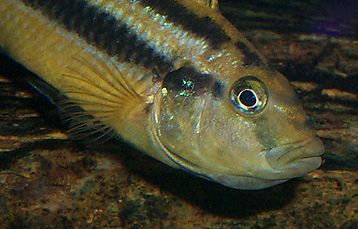Orange Blue Mouth Breeder Orange Blue Mouth Breeder Cichlid
Breeding
Mouth-brooding African cichlid mating occurs something like this: the male digs out a cave (nest) for the female and lures her in by doing this silly fin shaking dance (there's also a disturbing "kissing" version). She lays her eggs in the nest and he fertilizes them. Then she picks up the eggs in her mouth and carries them until they hatch.

The eggs will hatch between 10-15 days after fertilization. The female then hold the babies in her mouth for up to two more weeks, occasionally letting them out to feed them. Most new mothers will start releasing the babies about 2 weeks after you notice they are carrying them, but will suck them back in when danger threatens. New mothers also have very small batches of eggs: around 10 or so. A mature female will have up to 30 eggs.
The male fish has no part in the care and raising of young, and may happily eat the babies if he is present when they are released. I suggest a 10-15 gallon tank for the mother and babies. Make sure the new tank is fully cycled and give it lots of tiny hiding places for the babies. You can also try providing small hiding places for the baby fish in your main tank, but in my experience the adult fish find ways to eat the babies.
If you intend to breed your fish, you should only get one species from any given genus. So for instance you might have 5 Pseudotropheus socolofi and 5 Melanchromis chipokae, but you wouldn't want to get any more Pseudotropeus or Melanochromis. Sometimes Mbuna of the same genus but different species will interbreed and the offspring are either ugly, sterile or both. I don't follow this rule with my tank, but I pay attention to which fish are breeding and only save the fry from same-species pairings. Also, I've found that if you provide a male and at least one female of each species, you don't have to worry as much because the fish do prefer their own species.
In order to be sure you get at least one male and one female, I recommend getting four or five fish of each species and then if you accidentally get two males, selling the one you like the least back to the pet store as soon as it starts displaying its male coloration. Mouth-brooders like to be in a harem of the same species: one male and three or four females. The male will boss the females around but won't hurt them. Two mature males will shred each other until one dies.
There are a few tips you can use to guess the gender when picking fish out at the pet store:
- The dominant male is always the most aggressive fish in the tank.
- Males are more likely to have yellow spots on their anal fins (called "fin spots") than female fish. The anal fin is the lower fin just before the tail. Fin spots on males tend to be more irridescent, brighter and greater in number than the fins spots on females.
- Male fish dig holes in the gravel more often than females.
When the fish hits maturity at around 9 months, you can decisively sex the fish using the "one hole/two hole" method. Net the fish and hold it upside down in your hand (not for too long or it will suffocate in the air). Male fish have one obvious hole and one very small, barely detectable hole just past their anal fin. Female fish have two equally sized holes. I've never been very good at judging this though, and the fish sold at pet stores are usually too young to sex this way anyway.
Comments? Questions? Contact l x s @ m a c . c o m.
All pages copyright ©2000-2015 Alexandra Ellwood.
Last modified at Sunday, April 19, 2015
Source: https://www.mit.edu/~lxs/cichlids/breeding.html
0 Response to "Orange Blue Mouth Breeder Orange Blue Mouth Breeder Cichlid"
Post a Comment